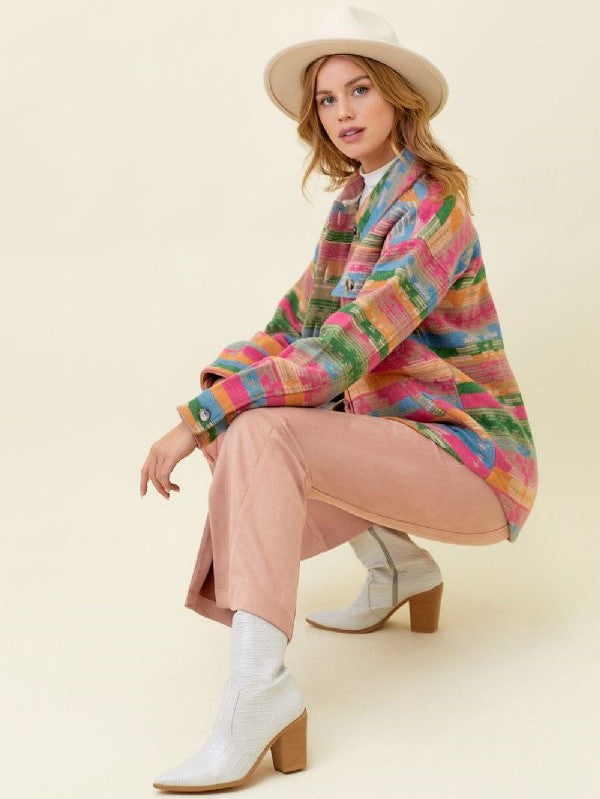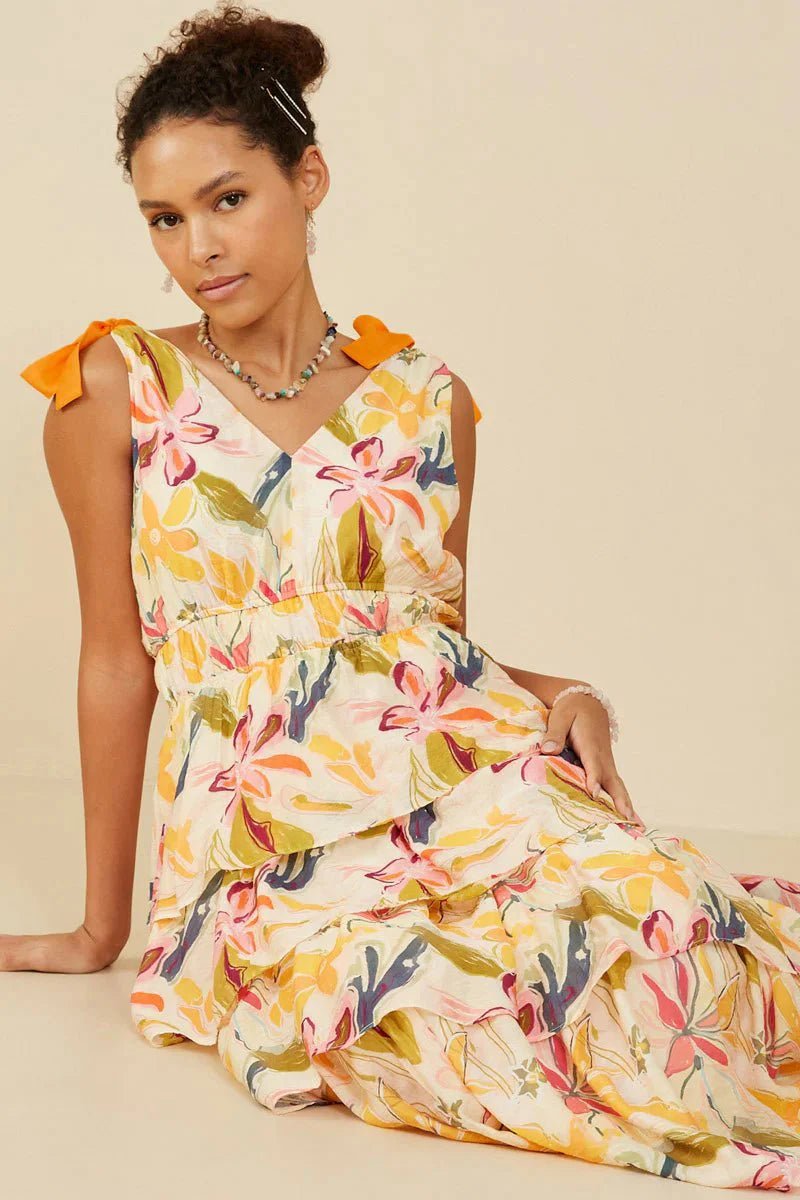The relationship between social media and fashion has fundamentally altered how trends emerge, spread, and fade in contemporary culture. What once took months or even seasons to trickle from runways to mainstream adoption now happens in a matter of days or hours, creating both unprecedented opportunities and unique challenges for fashion brands and consumers alike.
The Acceleration of Trend Cycles
Social media has compressed the traditional fashion calendar into something almost unrecognizable from its pre-digital form. Trends that might have taken seasons to develop and spread now gain momentum within weeks, sometimes catching even industry professionals off guard with their rapid adoption and equally swift decline.
This acceleration has created interesting opportunities for pieces with staying power. Items like our textured floral tiered v-neck dress benefit from this environment because their classic silhouette with contemporary details allows them to work across multiple micro-trends. The v-neck cut photographs beautifully for social media while the textural elements provide the visual interest that performs well in digital formats.
The rapid cycle has also placed new emphasis on versatility and styling potential. Consumers increasingly seek pieces that can be styled multiple ways for different social media contexts, making items like our floral contrast piped tiered dress particularly valuable. The contrast piping adds visual definition that translates well to photography, while the tiered silhouette can be styled up or down depending on the desired aesthetic.
Platform-Specific Influence Patterns
Different social media platforms have developed distinct roles in fashion trend propagation, each with its own aesthetic preferences and user behaviors. Instagram tends to favor polished, aspirational content that often features investment pieces and carefully curated styling approaches.
Pinterest functions more as a mood board and inspiration gathering space, where users collect and organize style ideas for future reference. This platform often drives longer-term trend development and helps sustain interest in particular aesthetic directions over time. Pieces with strong visual appeal and clear styling potential perform particularly well in this environment.
TikTok has emerged as perhaps the most powerful trend acceleration platform, where styling tips, outfit reveals, and fashion hacks can reach millions of viewers within hours. The platform's algorithm rewards engagement over follower count, meaning anyone can potentially influence fashion trends if their content resonates with viewers.
The Democracy of Fashion Influence
Social media has democratized fashion influence in ways that traditional media never could. While established fashion magazines and celebrity stylists maintain their importance, everyday users now have unprecedented power to shape trend directions through their content creation and engagement patterns.
This democratization has led to more diverse representation in fashion trends, with influences coming from various geographic regions, age groups, and style preferences. It's also created opportunities for smaller boutiques to compete with larger retailers by showcasing how their pieces work in real-life contexts rather than relying solely on traditional advertising approaches.
The shift has also changed how consumers discover and evaluate fashion pieces. Rather than relying primarily on professional styling and editorial photography, shoppers now see how items look on real people in authentic settings, leading to more informed purchasing decisions and different criteria for what makes a piece desirable.
Visual Storytelling and Fashion Photography
The visual nature of social media has fundamentally changed how fashion is presented and consumed. Professional photography techniques that once required studio settings and expensive equipment are now accessible to anyone with a smartphone and basic editing knowledge, leading to new visual storytelling approaches.
This accessibility has raised the bar for fashion photography across all contexts. Even casual outfit posts now often feature sophisticated lighting, composition, and editing techniques. Items that photograph well have distinct advantages in this environment, particularly pieces with interesting textures, flattering silhouettes, or photogenic details.
The emphasis on visual appeal has also influenced design trends themselves. Details that might have been subtle in pre-social media fashion are now amplified to ensure they read clearly in photographs. This has led to more pronounced textural elements, clearer silhouette definition, and bolder design choices that maintain their impact when translated to small smartphone screens.
The Psychology of Social Validation
Social media has introduced new psychological elements to fashion consumption through the immediate feedback mechanisms of likes, comments, and shares. This real-time validation can significantly influence both individual style choices and broader trend adoption patterns.
The desire for social media engagement has led many consumers to prioritize pieces that generate positive responses online, sometimes over personal preference or practical considerations. This has created interesting opportunities for items that strike the right balance between trend-awareness and timeless appeal.
Understanding this psychology has become crucial for fashion brands seeking to create pieces that perform well in social media environments. Success requires considering not just how an item looks and feels in person, but how it will be perceived and shared in digital contexts. The most successful pieces often combine photogenic qualities with genuine style merit and practical wearability.
Influencer Culture and Authentic Recommendations
The rise of fashion influencers has created new pathways for trend dissemination, but it has also led to increased consumer sophistication about sponsored content and authentic recommendations. Modern consumers are highly skilled at distinguishing between genuine enthusiasm and paid promotion, making authentic influence more valuable than ever.
This shift has created opportunities for boutiques to build genuine relationships with content creators who align with their brand values and aesthetic direction. Rather than purely transactional influencer relationships, the most successful partnerships often involve ongoing collaboration and authentic integration of products into influencers' personal style narratives.
The trend toward micro-influencers and nano-influencers reflects this desire for authenticity. Smaller creators often have higher engagement rates and more genuine relationships with their audiences, making their recommendations more impactful than those from creators with massive but less engaged followings.
The Challenge of Digital vs. Reality
One of the most significant challenges created by social media's fashion influence is the potential disconnect between how items appear online versus in reality. Lighting, angles, editing, and styling can dramatically alter how pieces appear, sometimes leading to disappointment when items don't meet digitally-enhanced expectations.
This challenge has led to increased importance of accurate product representation and detailed information about fit, fabric, and construction. Successful fashion brands now invest heavily in creating multiple types of content that show their pieces from various angles, on different body types, and in various lighting conditions.
The gap between digital presentation and reality has also created opportunities for brands that prioritize genuine quality and accurate representation. When pieces consistently meet or exceed expectations based on their social media presentation, it builds trust and loyalty that transcends individual trend cycles.
Real-Time Feedback and Design Evolution
Social media provides fashion brands with unprecedented access to real-time consumer feedback, allowing for rapid adjustments to design, production, and marketing strategies. Comments, direct messages, and engagement patterns provide immediate insights into what resonates with target audiences.
This feedback loop has accelerated design evolution, allowing brands to respond quickly to consumer preferences and emerging trend directions. It has also created new challenges around managing diverse opinions and feedback while maintaining coherent brand identity and design vision.
The immediacy of social media feedback has also changed how fashion mistakes are handled. Poor design choices or quality issues can be amplified quickly, but brands that respond thoughtfully and transparently often emerge stronger from such challenges.
The Future of Social Media Fashion Influence
As social media platforms continue to evolve and new platforms emerge, the relationship between digital media and fashion trends will likely become even more complex and nuanced. Emerging technologies like augmented reality and virtual try-on features are already beginning to change how consumers interact with fashion online.
The increasing sophistication of social media users suggests that future success will require even more authentic, valuable, and well-executed content. Brands that can provide genuine style inspiration, educational content, and transparent communication are likely to thrive in this evolving landscape.
Understanding social media's impact on fashion trends isn't just important for industry professionals—it's become essential knowledge for anyone seeking to navigate modern fashion consumption thoughtfully. The key lies in using these platforms as tools for inspiration and discovery while maintaining personal style authenticity and making choices that serve individual needs rather than purely social validation.
The relationship between social media and fashion will continue evolving, but its fundamental impact on how we discover, evaluate, and share style choices has permanently altered the fashion landscape. Success in this environment requires balancing digital savvy with genuine style understanding and authentic personal expression.





